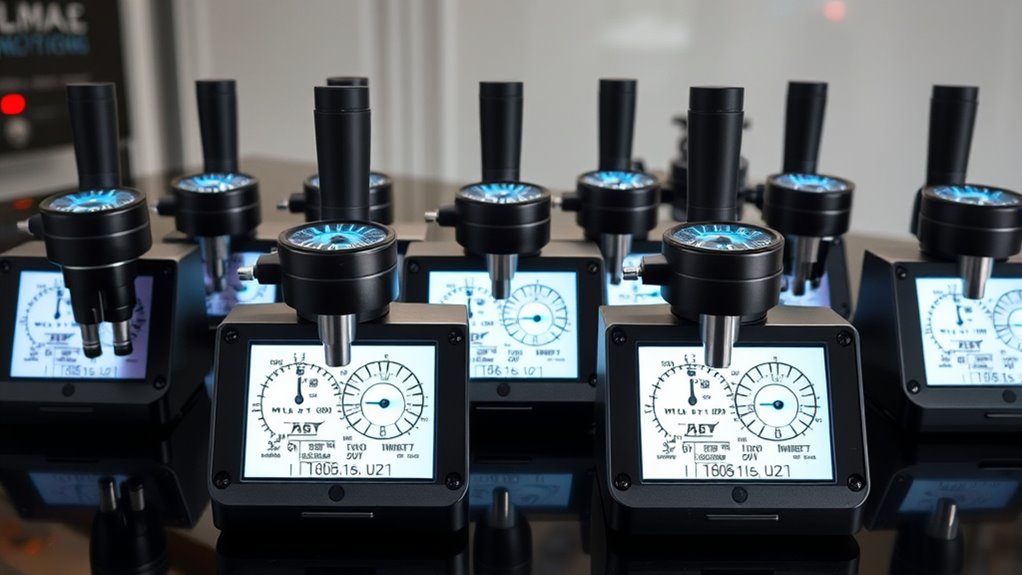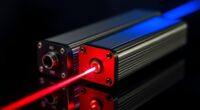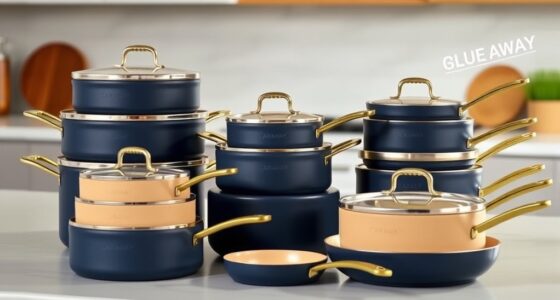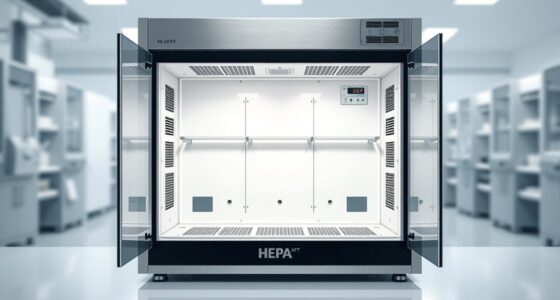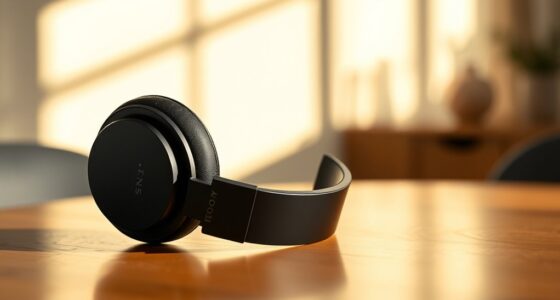If you’re searching for the best optical comparators in 2025, I recommend options like Fowler’s portable 10x comparator with high-precision reticles, along with digital tools like the Smart-Tool protractor offering ±0.1° accuracy. Compatibility with overlays, fiber optic inspection probes, and gemstone testers also play vital roles in thorough quality control. If you keep exploring, you’ll discover detailed features and tips to help you choose the right instrument for your inspection needs.
Key Takeaways
- High-precision optical comparators with adjustable overlays enhance measurement accuracy for quality control inspections.
- Portable optical comparison tools like Fowler 52-664-009-0 offer detailed magnification for field inspections.
- Compatibility with large-screen profile projectors and durable Mylar overlays improve inspection reliability.
- Digital measurement devices, such as protractors and Lensmeters, complement optical comparators for comprehensive quality checks.
- Robust construction and specialized features ensure durability and suitability for various industrial and inspection applications in 2025.
Fowler 52-664-009-0, 10x Pocket Optical Comparator Set with 9 Recticles
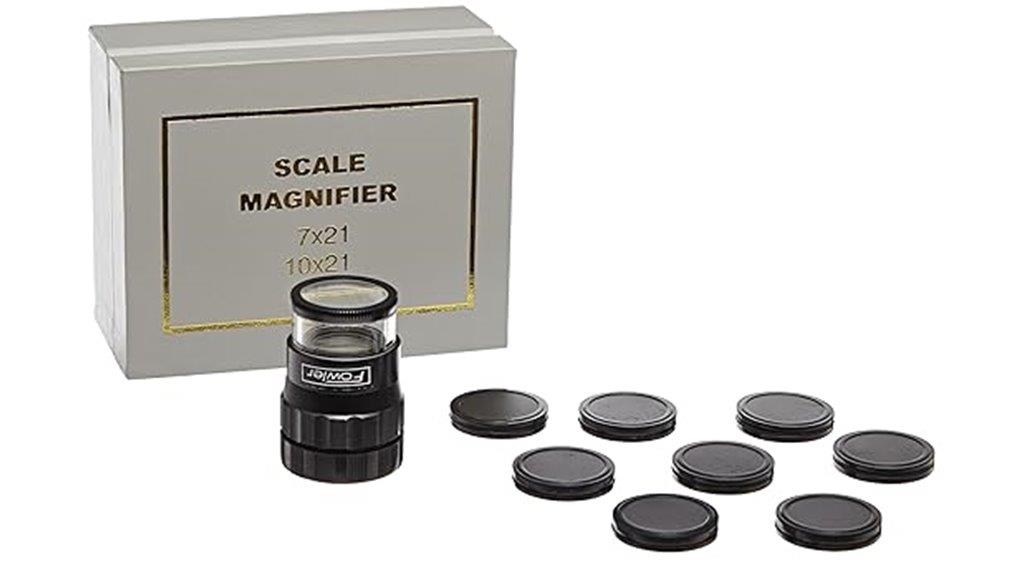
If you’re looking for a compact and precise tool for detailed inspection tasks, the Fowler 52-664-009-0 10x Pocket Optical Comparator Set is an excellent choice. It features a high-resolution glass lens with 10X magnification, perfect for measuring line thickness, screw threads, angles, radii, circles, and lengths. The set includes nine photo-etched glass reticles, each designed for specific measurements like circle, square, and angle. These reticles provide distortion-free, highly accurate readings, whether you’re working with metric or imperial units. Its portability and versatility make it ideal for on-the-go inspection and quality control tasks.
Best For: precision inspectors, quality control specialists, and engineers needing portable, high-accuracy measurement tools for detailed inspection tasks.
Pros:
- High-resolution 10X magnification with distortion-free glass lens for accurate readings
- Includes nine diverse reticles for measuring angles, circles, threads, and linear dimensions
- Compact, portable design ideal for on-the-go inspection and fieldwork
Cons:
- Limited to 10X magnification, which may not suit very detailed microscopic inspections
- Requires proper lighting and stable positioning for optimal accuracy
- Reticles may need careful handling to prevent damage or misalignment
Smart-Tool 09429606 Pro 360 Digital Protractor, +/-0.1 Degree Accuracy
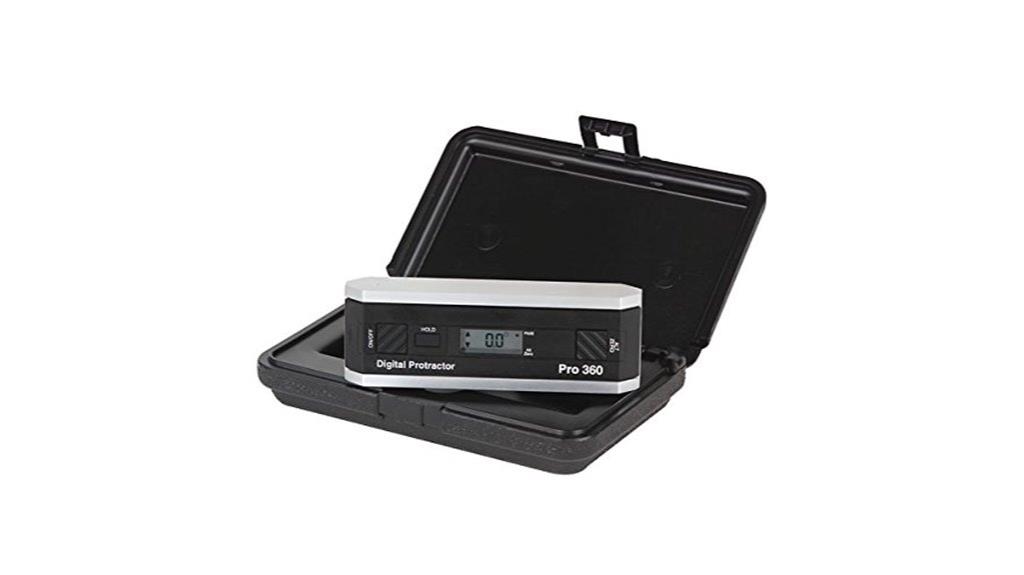
The Smart-Tool 09429606 Pro 360 Digital Protractor stands out for its exceptional ±0.1° accuracy, making it ideal for professionals who require precise angle measurements in demanding applications. Its 0.1° resolution and full 360° range enable accurate readings on round objects like pipes and shafts, as well as setting driveline angles or leveling turntables. Constructed with a lightweight, machined aluminum frame, it’s durable and easy to handle. The LCD display flips for easy viewing, and it can be recalibrated in the field without special tools. Powered by a long-lasting 9V battery, it’s a reliable, portable tool for high-precision tasks in various industries.
Best For: professionals and enthusiasts needing highly accurate angle measurements for tasks like vehicle alignment, pipe fitting, and precision leveling.
Pros:
- Extremely precise with ±0.1° accuracy, ideal for demanding applications
- Full 360° measurement range with easy-to-read digital display that flips for convenience
- Durable lightweight aluminum construction with field recalibration capability
Cons:
- Requires a 9V battery, which may need replacement over time
- May be more expensive than traditional spirit levels or simpler angle tools
- Slight learning curve for users unfamiliar with digital protractors
Optical Comparator Chart for Profile Projector Overlay Chart
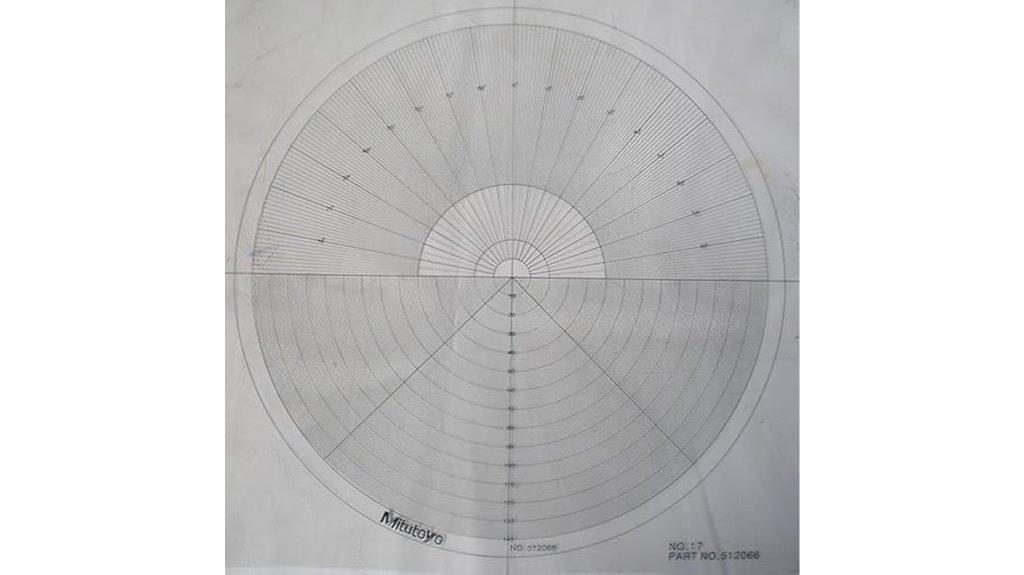
Optical comparator charts for profile projectors are ideal for professionals who need precise overlay measurements during detailed profile analysis. I find that the Mitutoyo 512066 chart enhances measurement accuracy on compatible projectors with 300mm or larger screens. This Mylar overlay facilitates detailed comparisons, featuring a protractor with 1º graduations and concentric semicircles with 1mm radii. It simplifies complex measurements, ensuring precise overlaying of profiles. Packaged as a single unit, this chart is perfect for technical and engineering applications requiring meticulous profile evaluation. Overall, it’s a valuable tool that improves inspection accuracy, making detailed profile analysis more efficient and reliable.
Best For: professionals in technical, engineering, or quality control fields who require precise profile overlay measurements using compatible profile projectors with screens of 300mm or larger.
Pros:
- Enhances measurement accuracy with detailed overlay features such as a 1º graduated protractor and concentric semicircles.
- Facilitates easier and more precise profile comparisons, improving inspection reliability.
- Compatible with Mitutoyo 512066 and suitable for detailed technical and engineering applications.
Cons:
- Designed specifically for projectors with screen diameters of 300mm or larger, limiting its use with smaller devices.
- Single overlay chart may require multiple copies for extensive or repeated measurements.
- May require familiarity with optical comparison techniques for optimal use.
SUXING Optical Comparator Chart for Profile Projector
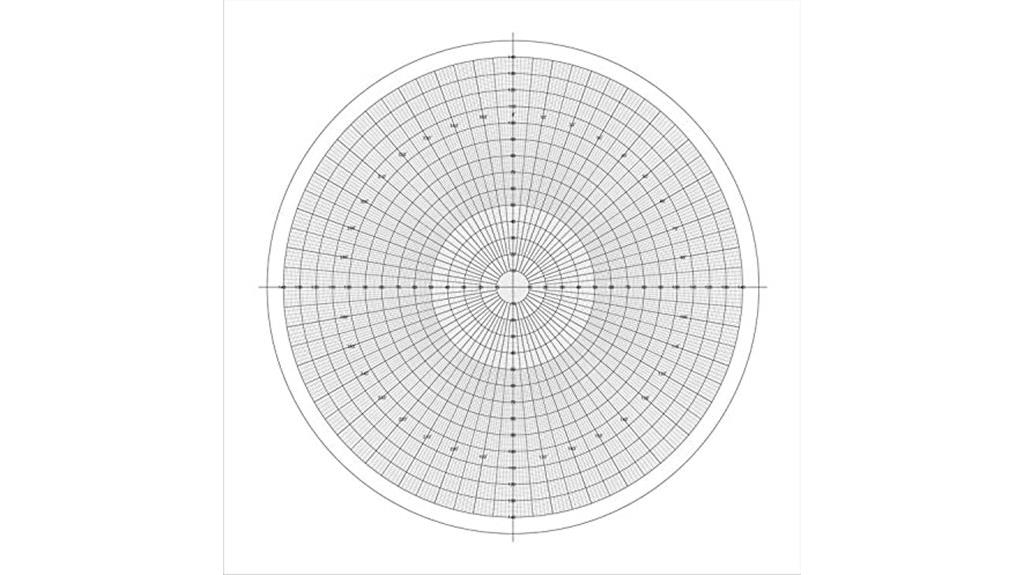
For professionals who need precise overlay references on profile projectors, the SUXING Optical Comparator Chart model 512075 stands out. This large 300mm x 300mm Mylar chart offers a durable, flexible overlay compatible with Mitutoyo, Nikon, and other profile projectors. Its extensive size allows for detailed profiling and accurate measurements. Designed specifically as an overlay for optical comparators, it ensures precise alignment and inspection. Each package includes one chart, making it a cost-effective choice. Don’t waste your money—invest in a reliable, high-quality tool that enhances your measurement accuracy and inspection efficiency on the profile projector.
Best For: professionals and technicians who require precise overlay references and measurements on profile projectors for detailed inspection and quality control.
Pros:
- Large 300mm x 300mm overlay area for comprehensive profiling.
- Made of durable, flexible Mylar material ensuring longevity and ease of handling.
- Compatible with multiple profile projector brands like Mitutoyo and Nikon, offering versatile use.
Cons:
- Single chart per package may require multiple purchases for extensive use.
- May be more expensive compared to generic overlays, despite emphasizing cost-effectiveness.
- Requires proper alignment to ensure measurement accuracy on the profile projector.
TEMPO OPM210 Optical Power Meter with Visual Fault Locator
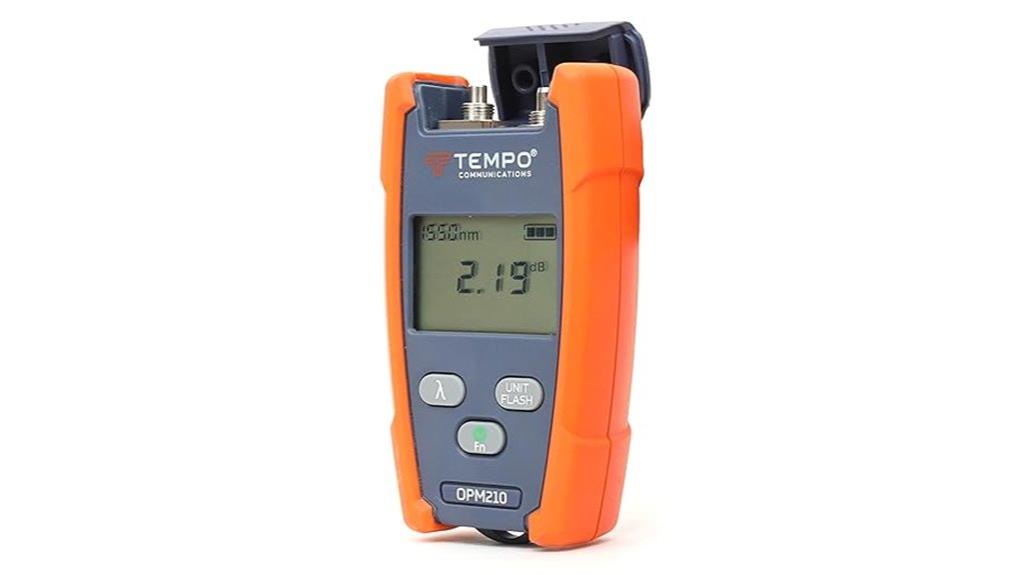
If you’re seeking a reliable tool that combines precise optical power measurements with built-in fault detection, the TEMPO OPM210 stands out. It measures power from -70 to +10 dBm across wavelengths 850-1650 nm, supporting both singlemode and multimode networks. Its integrated visual fault locator with a 650nm laser helps identify bends, faulty connectors, and fiber breaks. Designed for field use, it’s rugged, portable, and easy to operate, with a clear display and simple modes. Although some attachments may fit loosely, its high sensitivity, broad compatibility, and reliable performance make it an excellent choice for fiber optic testing and troubleshooting.
Best For: technicians and network professionals seeking a durable, accurate fiber optic testing tool with built-in fault detection for field applications.
Pros:
- High sensitivity with precise power measurement across a broad wavelength range (850-1650 nm).
- Integrated visual fault locator (VFL) for quick identification of bends, breaks, and faulty connectors.
- Compact, rugged design with easy-to-read display and multiple testing modes, ideal for field use.
Cons:
- Some optical attachments may fit loosely, causing potential fitment issues.
- The 1mW VFL might not be effective in outdoor or brightly lit environments.
- Lacks rechargeable batteries and a dedicated carry case, which could enhance portability and convenience.
Optical Comparator Chart for Profile Projector Overlay Chart NO 13
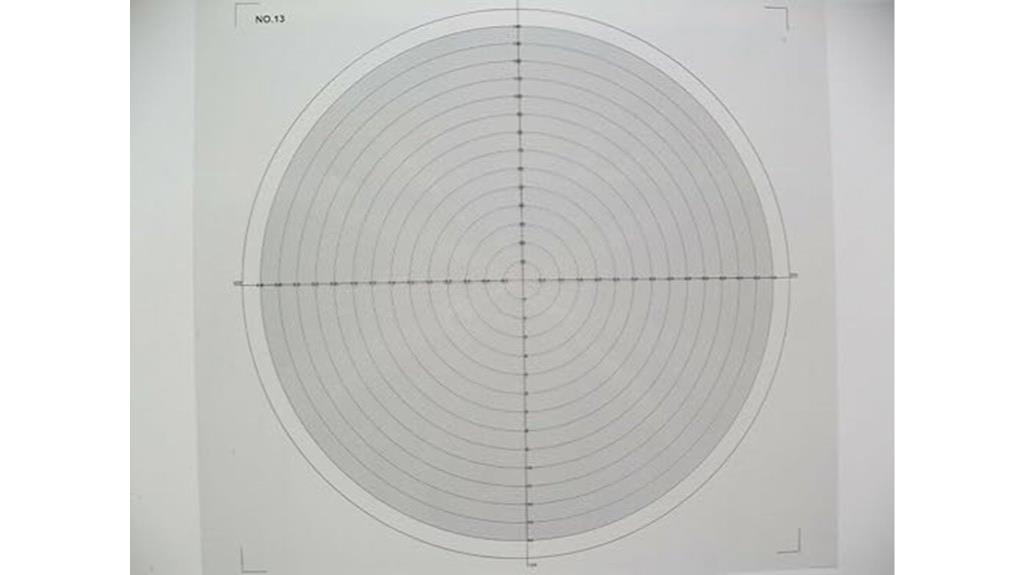
The Optical Comparator Chart for Profile Projector Overlay NO 13 is an excellent choice for professionals who require precise and versatile measurement tools on larger screen profile projectors. Designed for use with projectors featuring 300mm or larger screens, it offers reliable overlays for accurate inspection. Made from durable Mylar, it maintains precision over time. The chart provides multiple radius options (1X, 10X, 20X, 50X), enabling detailed measurements for various applications. Each package includes a single overlay chart, making it a practical addition to any inspection setup, ensuring consistent, high-quality results in demanding environments.
Best For: professionals needing precise overlay measurement tools on large-screen profile projectors for accurate inspection and quality control.
Pros:
- Compatible with profile projectors featuring screen diameters of 300mm or larger, ensuring versatile application.
- Made from durable Mylar for long-lasting precision and reliability.
- Offers multiple radius options (1X, 10X, 20X, 50X) for detailed and varied measurements.
Cons:
- Supplied as a single overlay per package, which may require additional purchases for multiple setups.
- Designed specifically for larger screen projectors, limiting use on smaller equipment.
- May require careful handling to prevent damage to the Mylar overlay during use.
Fowler 52-664-009-0 10X Optical Comparator Set (2 pcs)
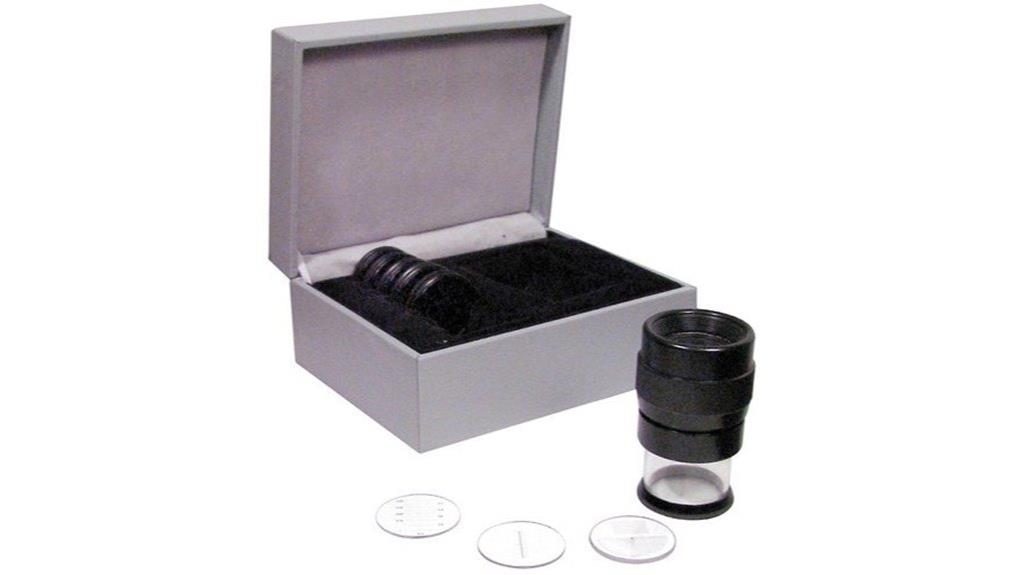
When precision measurement of small features is essential, the Fowler 52-664-009-0 10X Optical Comparator Set stands out as an ideal tool for machinists, toolmakers, and inspectors. This set, consisting of two units, offers sharp, undistorted magnification thanks to its 10X optics. The glass reticles with photo-etched scales allow accurate checking of angles, threads, hole sizes, and more, with easy interchangeability. An included illuminator makes it versatile for detailed inspections in various lighting conditions. Compact and portable, this comparator set enables quick, precise measurements on the spot, making it a valuable addition to any quality control process.
Best For: machinists, toolmakers, and inspectors who need portable, high-precision measurement of small features in industrial settings.
Pros:
- Provides sharp, undistorted 10X magnification for detailed inspections
- Interchangeable glass reticles with photo-etched scales for accurate measurements
- Includes an illuminator attachment for versatile lighting conditions
Cons:
- Limited to small-scale measurements, not suitable for larger objects
- Requires careful handling to prevent glass reticle damage
- May necessitate additional calibration for highly precise applications
Optical Retinoscopy Rack Lens Set with Aluminum Case
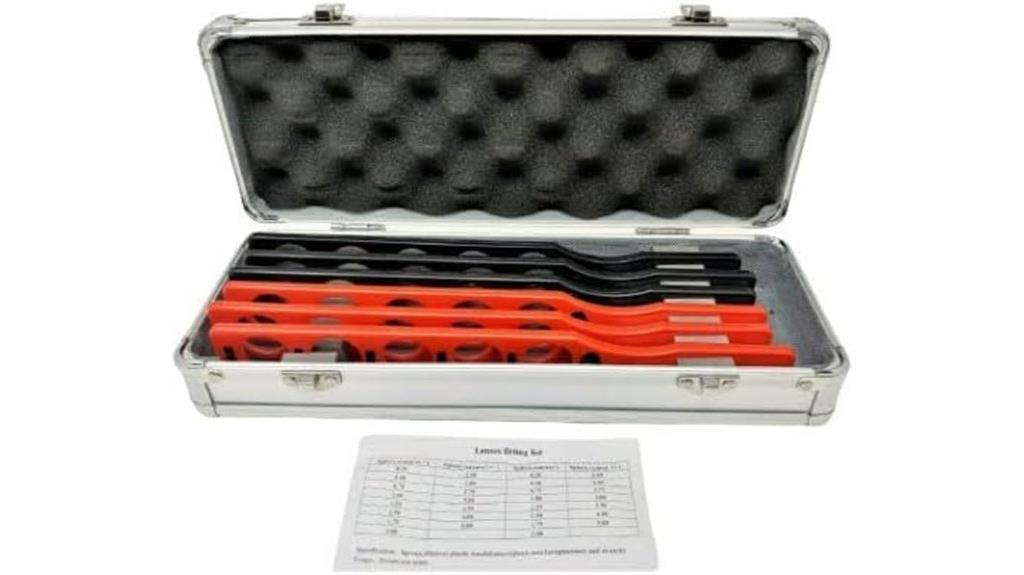
Designed specifically for ophthalmic practitioners, the Optical Retinoscopy Rack Lens Set offers a precise and efficient solution for refraction examinations. It includes 30 plastic trial lenses mounted on six bars, with 16 lenses per bar, covering both convex (+) and concave (-) options from ±0.25 to ±5.00 diopters. The lenses, with a 25mm diameter, enable faster, more accurate retinoscopy, saving time and improving patient care. Housed in a durable aluminum case, the set is portable and easy to store. Constructed from environmentally friendly, high-quality plastic, it guarantees safety, durability, and long-lasting performance for daily clinical use.
Best For: ophthalmic eye care professionals seeking a reliable, portable set of trial lenses for accurate and efficient refraction examinations.
Pros:
- Facilitates faster and more precise retinoscopy, saving clinical time.
- Made from high-quality, environmentally friendly plastic ensuring safety and durability.
- Comes with a sturdy aluminum case for convenient storage and transportation.
Cons:
- Limited to trial lenses within the diopter range of ±0.25 to ±5.00, which may not suit all specialized needs.
- Plastic construction, while durable, may be less resistant to heavy impacts compared to metal alternatives.
- No integrated lighting or electronic features, requiring separate illumination for use in dim environments.
Professional Digital Lensmeter Auto Focimeter for Optical Labs (JD-2600C)
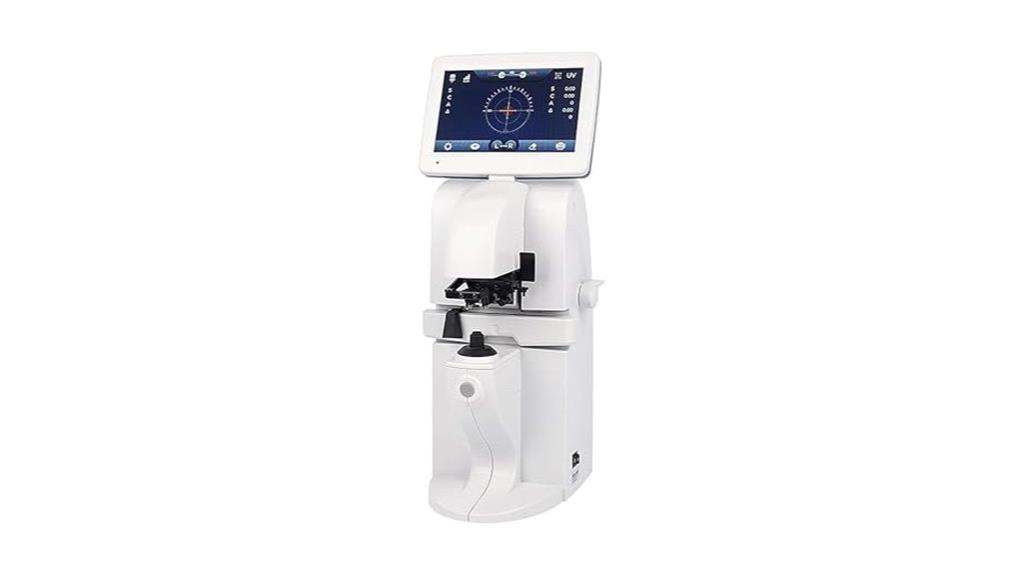
If you’re looking for a highly precise and efficient tool for optical labs, the JD-2600C Digital Lensmeter stands out thanks to its advanced measurement technology. It uses Hartmann Array technology and a 108-point system to achieve 0.01D resolution across various parameters, including spherical, cylindrical, axial, prismatic, and UV transmittance. Its high-definition imaging guarantees accurate results for single vision, bifocals, and progressives. The device supports calibration for different lens types, measures pupil distance, and integrates UV/blue light testing. With a user-friendly 7-inch touchscreen, durable build, and instant data printing, it streamlines workflows and guarantees clinical-grade precision.
Best For: optical laboratories and optometrists seeking high-precision, efficient lens measurement with advanced calibration and testing features.
Pros:
- Utilizes Hartmann Array technology and 108-point system for exceptional 0.01D measurement resolution.
- Supports comprehensive parameters including UV transmittance, prism, and axis with high-definition imaging.
- User-friendly 7-inch touchscreen and integrated UV/blue light testing streamline workflow and enhance accuracy.
Cons:
- May require training to fully utilize advanced calibration and measurement functions.
- Higher initial investment compared to basic lensmeters.
- Dependence on electronic components could pose challenges in environments with unstable power or extreme conditions.
KEZERS 32X Automatic Optical Level Kit
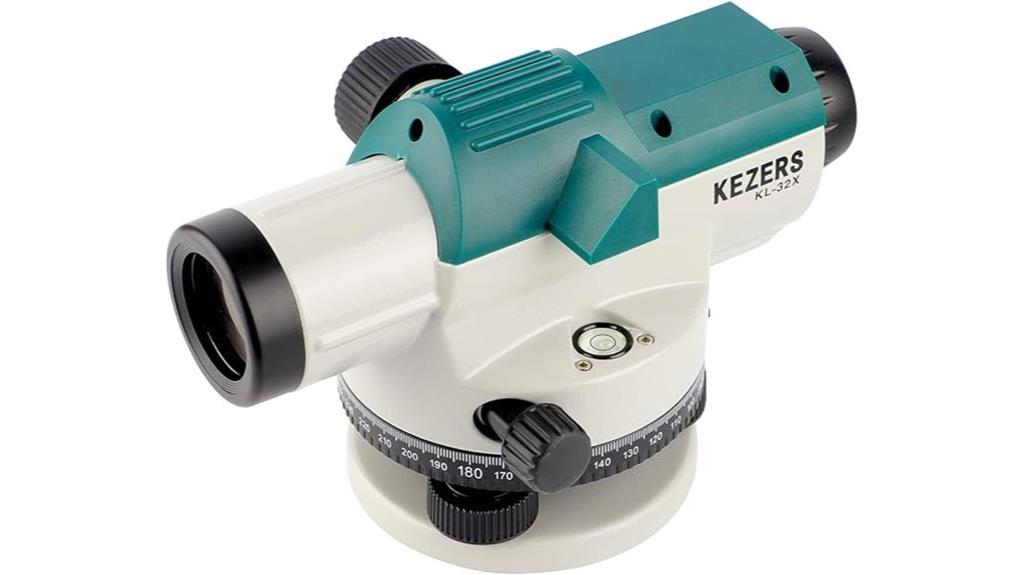
The KEZERS 32X Automatic Optical Level Kit stands out for outdoor professionals who need precise leveling and surveying over long distances. With 32X magnification and a 36mm aperture, it’s suitable for work within a 393-foot range. Its high accuracy of 1/16 at 100 feet, combined with weather-resistant all-metal construction, ensures durability in tough conditions. The self-leveling system stabilizes measurements quickly, even on uneven sites. Easy to set up with clear crosshairs and a sturdy tripod, users appreciate its reliability. No batteries are needed, making it a portable, efficient tool for foundation work, surface analysis, and construction layout.
Best For: outdoor surveying and leveling professionals seeking a durable, accurate, and portable optical level for long-distance measurement tasks.
Pros:
- High magnification of 32X combined with a 36mm aperture for clear, detailed viewing over long ranges.
- All-metal weather-resistant construction ensures durability and reliable performance in outdoor conditions.
- Self-leveling system with magnetic damping provides quick stabilization, reducing setup time and measurement errors.
Cons:
- Crosshair visibility may diminish at certain distances if not properly adjusted.
- No power source or batteries required, which limits additional electronic features but may be a disadvantage for those seeking digital functionalities.
- Slightly heavier weight (5.35 pounds) compared to some plastic-bodied models, possibly affecting portability for extended field use.
Fiber Inspection Video Probe with HD LCD Display and Multiple Tips
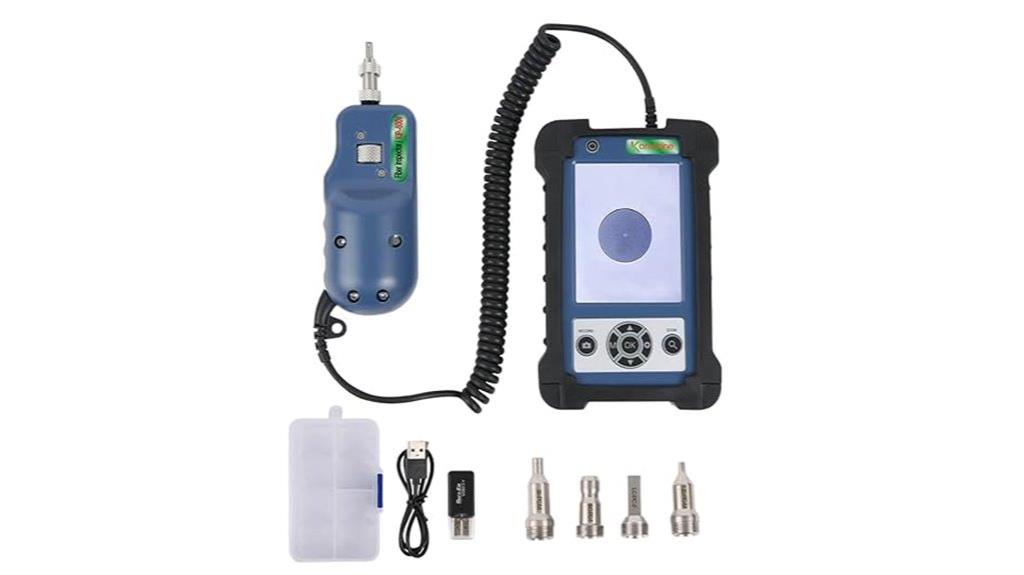
For professionals seeking precise and efficient fiber inspections, the Fiber Inspection Video Probe with HD LCD Display and Multiple Tips offers an exceptional solution. It delivers 400x magnification with real-time video, compatible with various connector types like SC, FC, ST, and LC. The 3.5-inch HD LCD screen provides clear visuals, while the user-friendly interface simplifies operation. With features like data recording, measurement review, and pollution checks, it enhances inspection workflows. Powered by a robust 4000mAh battery, it supports long outdoor use. Its compact design and multiple tips make it ideal for detailed fiber end-face assessments in both field and lab environments.
Best For: professionals and technicians requiring precise, portable fiber end-face inspection and pollution assessment in field or lab environments.
Pros:
- High-resolution 400x magnification with real-time video for detailed inspections
- User-friendly 3.5-inch HD LCD display and simple interface for quick operation
- Long-lasting 20-hour battery and portable design ideal for outdoor and extended use
Cons:
- Limited compatibility with certain APC connectors unless additional tips are purchased
- May require familiarity with fiber connector types for optimal use
- Slightly larger size compared to handheld tools, which could affect portability in very tight spaces
TEKCOPLUS 10x 18mm Darkfield LED Loupe Gem Tester with Flashlight
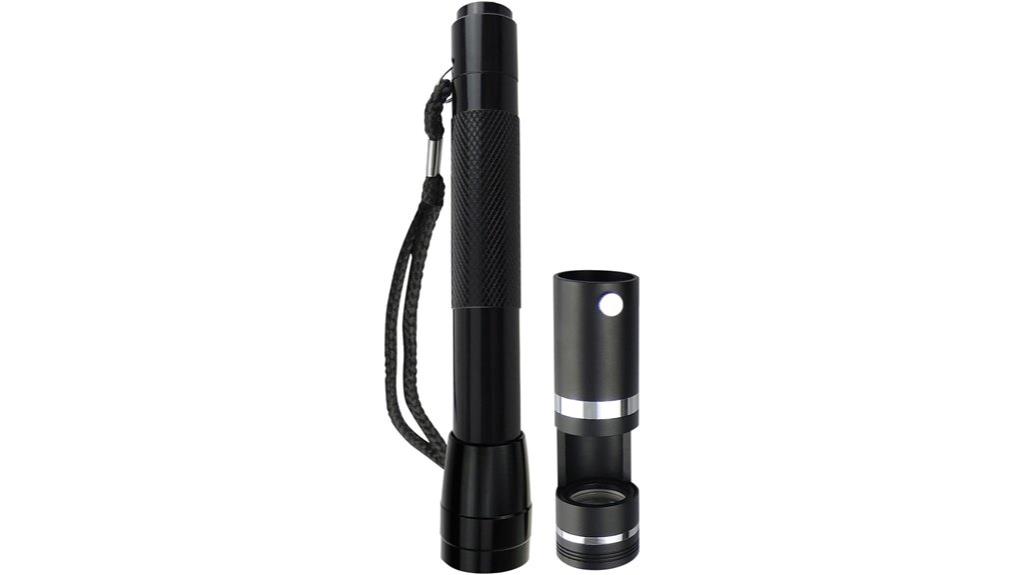
The TEKCOPLUS 10x 18mm Darkfield LED Loupe Gem Tester is ideal for jewelers and gemologists seeking accurate, professional-grade inspection tools. Its advanced optics provide 10x magnification, revealing internal features and stresses in gemstones. The built-in LED flashlight ensures consistent illumination, making detailed analysis straightforward in any environment. It can distinguish between isotropic and anisotropic gems and detect internal stresses, helping identify natural versus synthetic stones. The conoscope function enhances optical characterization, while its durable aluminum construction guarantees longevity. Whether in a lab or retail setting, this loupe offers precise, reliable gemstone inspection, making it a valuable addition to any jewelry professional’s toolkit.
Best For: jewelers and gemologists seeking a professional-grade, durable loupe with advanced optical features for precise gemstone analysis.
Pros:
- High-quality 10x magnification with 18mm darkfield lens for detailed internal inspection.
- Built-in LED flashlight provides consistent illumination suitable for various lighting conditions.
- Conoscope function enhances optical characterization and pattern analysis.
Cons:
- Some users may find the operation challenging due to complexity in handling advanced features.
- Heavier weight (2.2 pounds) might be less convenient for extended handheld use.
- Limited user reviews and feedback could indicate a need for further product testing and user familiarity.
Factors to Consider When Choosing Optical Comparators for Inspection
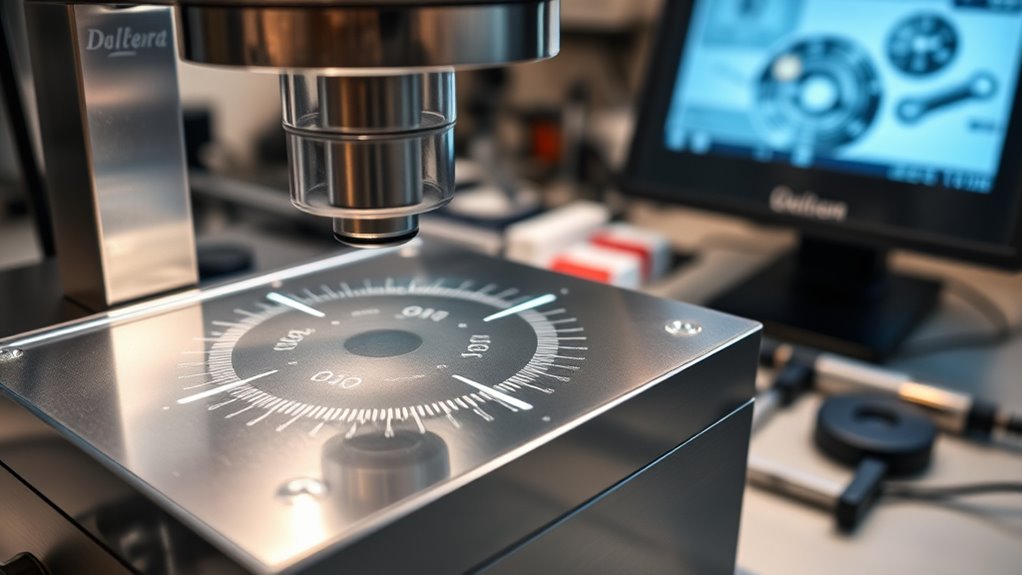
When selecting an optical comparator, I consider several key factors to guarantee it meets my inspection needs. These include choosing the right magnification power, verifying reticle compatibility, and ensuring measurement accuracy. Additionally, optical clarity and build quality are vital for reliable, long-term use.
Magnification Power Selection
Have you ever wondered how to choose the right magnification for an optical comparator? The key is matching magnification to the features you need to inspect. Typically, comparators range from 5X to 50X; higher magnifications reveal finer details but narrow the field of view. For small, intricate parts, going for a higher magnification makes sense, but it also demands precise alignment and stable mounting to prevent distortion. Conversely, lower magnifications provide a broader view, making it easier to locate features quickly but may miss tiny imperfections. It’s a balance between detail and area coverage. Consider the measurement accuracy you require—over-magnifying can exaggerate errors, while under-magnifying might overlook critical features. Finding the right compromise guarantees effective, accurate inspections.
Reticle Compatibility & Types
Choosing the right reticle type for an optical comparator is essential because it directly affects measurement accuracy and ease of use. Different models support various reticle types, such as glass, Mylar overlays, or photo-etched scales, each suited to specific inspection tasks. Compatibility depends on the comparator’s design and the measurements needed, like angles, radii, threads, or linear dimensions. Some reticles are interchangeable or customizable, allowing you to tailor scales to your inspection requirements. Features like concentric circles, graduated scales, and specialized patterns improve measurement precision and simplify alignment. Ultimately, selecting a compatible reticle type ensures distortion-free viewing and reliable measurements, making it a vital factor in optimizing your comparator’s performance for quality control.
Measurement Accuracy & Resolution
To achieve high measurement accuracy with optical comparators, it’s essential to pay close attention to the quality of the reticles and lenses. Precise reticles and high-resolution lenses ensure reliable readings within tight tolerances, which is critical for quality control. Resolution, expressed in micrometers or arcminutes, determines the smallest feature or angle we can measure, directly affecting inspection detail. The clarity and distortion-free quality of glass components are indispensable for maintaining accuracy across the entire viewing field. While higher magnification levels, like 10x or more, enhance detail, they must be balanced with resolution capabilities to prevent loss of precision. Regular calibration and using top-quality optical parts are key to sustaining measurement accuracy and resolution over time.
Optical Clarity & Distortion-Free Viewing
Why is optical clarity so essential when selecting an optical comparator for inspection? Clear, sharp images are crucial for accurately measuring small features without misinterpretation. High-quality glass lenses ensure minimal distortion and maintain image integrity. Using photo-etched glass reticles helps preserve measurement accuracy without adding optical distortions. Proper optical design—such as appropriate magnification and lens coatings—reduces aberrations and improves clarity. Distortion-free viewing is vital for precise measurements of tiny details like holes, threads, and angles. Regular calibration and maintenance are also key to preserving optical clarity over time, preventing image degradation. Ultimately, choosing a comparator with excellent optical clarity guarantees reliable inspections, supports precise measurements, and upholds quality control standards in demanding environments.
Build Quality & Durability
A solid build quality is vital for optical comparators because it guarantees the device can withstand daily use and rough handling without compromising performance. I look for models with sturdy frames made from metal or reinforced materials, ensuring durability during frequent handling and transport. Dust-resistant or sealed optical components are essential, especially in industrial environments, to prevent contamination and damage. I also check that moving parts like sliding stages and reticle mounts operate smoothly and resist wear, maintaining consistent accuracy. High-quality lenses and glass elements should resist scratching, cracking, and fogging, preserving optical clarity over time. Protective features like weather-resistant casings and shock-absorbing design elements further enhance reliability, ensuring the comparator performs reliably even in harsh or outdoor conditions.
Ease of Use & Portability
Choosing an optical comparator that’s easy to operate and portable can considerably streamline inspection tasks. I look for models with intuitive controls and clear reticle markings, so measurements are straightforward and accurate. Lightweight and compact designs make setup quick and transportation effortless, especially when moving between workstations or sites. Features like flip-up displays and adjustable focus reduce operator fatigue and improve usability, saving time during inspections. Durability is also key, so I prefer models with rugged construction and protective casings that withstand demanding environments. Integrated carrying cases or accessories help keep equipment safe during transport, ensuring my workflow remains efficient. Overall, a user-friendly, portable comparator minimizes effort and maximizes productivity, making it a crucial tool for precise quality control.
Compatibility With Accessories
Selecting an optical comparator that seamlessly integrates with a variety of accessories can substantially enhance measurement flexibility. I look for models compatible with different reticle types, like glass or Mylar overlays, to suit various inspection needs. It’s important that the device supports large screen sizes, typically 300mm or more, to accommodate diverse overlay charts and projection methods. I also verify that optical and measurement accessories, such as protractors or radius charts, fit and work smoothly with the model. Additionally, the comparator should allow easy integration of extra tools like linear scales or concentric circle overlays without major modifications. Compatibility with digital or analog measurement accessories, including digital protractors or specialized reticle sets, further ensures precise, versatile inspections.
Price & Value Proposition
When evaluating optical comparators, understanding their price and overall value is essential to making a smart investment. Prices range from a few hundred dollars for basic models to several thousand for high-precision units. Higher-priced comparators typically offer advanced features like better optics, more reticle options, and increased measurement accuracy, which provide long-term value for critical inspections. Budget models may handle simple tasks but often sacrifice measurement precision and durability, potentially leading to costly errors or replacements. To assess the value proposition, compare features, build quality, measurement capabilities, and warranty against the price. Investing in a comparator with superior accuracy and robustness can save money over time by reducing errors, minimizing rework, and enhancing inspection reliability.
Frequently Asked Questions
How Do Optical Comparators Differ From Digital Measurement Tools?
Optical comparators use magnified images projected onto a screen for visual inspection, while digital measurement tools rely on electronic sensors to provide precise numerical data. I prefer optical comparators for their quick visual assessment and ability to compare parts against specifications directly. Digital tools, however, excel in delivering exact measurements and data logging. Both have their strengths, but I choose based on whether I need a visual check or detailed, numerical accuracy.
What Maintenance Is Required for Optimal Comparator Performance?
Maintaining an optical comparator is like tending to a delicate garden; regular care keeps it thriving. I regularly clean lenses with a soft cloth, check alignment, and calibrate the device to guarantee precision. Lubricating moving parts and inspecting light sources prevent issues. Periodic professional servicing also helps catch problems early. By staying proactive, I keep my comparator performing at its best, ensuring accurate, reliable measurements every time.
Can Optical Comparators Measure Complex or Irregular Shapes?
Yes, optical comparators can measure complex or irregular shapes, especially with advanced features like digital imaging and programmable overlays. I find them particularly useful because they allow me to compare intricate profiles against standard templates quickly. While some shapes may require additional setup or specialized accessories, overall, comparators are versatile tools that help me accurately inspect even the most challenging geometries, ensuring high-quality results every time.
How Does Lighting Affect the Accuracy of Optical Comparators?
Lighting is the paintbrush that helps me see every detail clearly with an optical comparator. Poor lighting can distort or hide flaws, like trying to read a map in dim light. Bright, even illumination guarantees accurate measurements by highlighting contours and edges, reducing shadows and glare. When I get the lighting right, my inspection becomes as precise as a finely tuned instrument, ensuring superior quality control every time.
Are Portable Optical Comparators Suitable for On-Site Inspections?
Yes, portable optical comparators are great for on-site inspections. I find them incredibly convenient because they allow me to quickly assess parts right at the manufacturing location without needing to transport items back to the lab. Their compact design makes it easy to handle in tight spaces, and they still provide precise measurements. For fieldwork, I highly recommend a reliable portable comparator to ensure quality control stays efficient and accurate.
Conclusion
If you’re worried about investing in the right optical comparator, I get it—accuracy is essential. But with so many options tailored for different inspection needs, choosing the right one isn’t as intimidating as it seems. Just consider your specific requirements and budget, and you’ll find a reliable tool that guarantees precise quality control. Trust me, the right comparator will make your inspections faster, easier, and more accurate.
